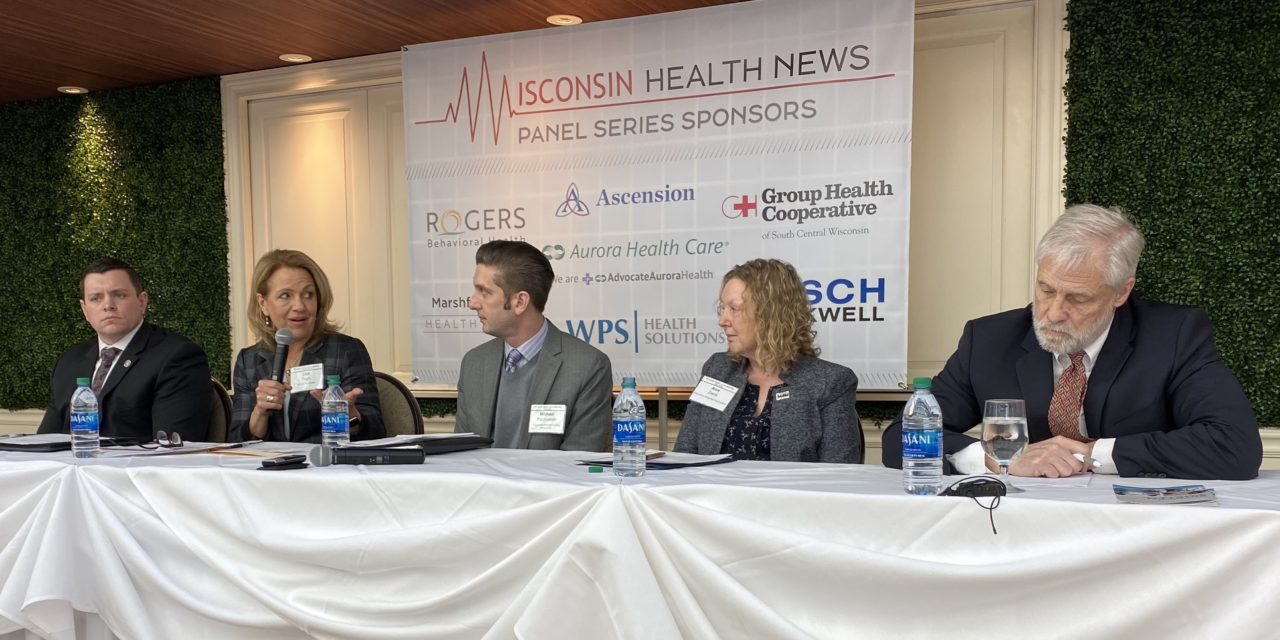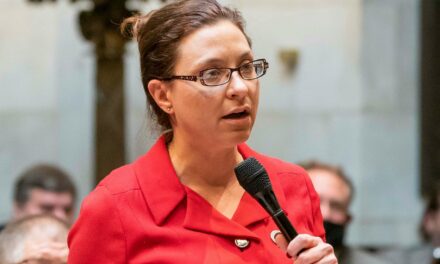
Panel tackles workforce challenges, solutions

Experts discussed challenges facing Wisconsin’s healthcare workforce, and potential solutions, at a Tuesday Wisconsin Health News event.
Panelists included:
- Michael Pochowski, CEO, Wisconsin Assisted Living Association
- Lisa Pugh, Executive Director, The Arc Wisconsin
- Sen. Patrick Testin, R-Stevens Point
- Dennis Winters, Chief Economist, Department of Workforce Development
- Ann Zenk, Vice President of Workforce and Clinical Practice, Wisconsin Hospital Association
WHN: Dennis, what are the main workforce challenges facing the state?
Dennis Winters: The Wisconsin workforce is great, right? The only problem we have is there’s not enough of us anymore. The silver tsunami, the Baby Boomers…are aging out. As I say, they’re kind of like the pig and the python. They change the whole social economic structure of the country, even the world, as they came into the workforce population. And now they’re aging out and going out the other end. So we have a quantity problem, which gets you a skills problem. So if you don’t have enough people, you’re just not going to have enough skilled people either…
Three things – one, it’s never happened before. We’ve never had to worry about this. So we need new solutions. Two, it’s not going away because we know the demographics and how it’s working. And the third thing, that’s primarily important for an economist, is that if you have a flattening workforce and you don’t raise the productivity of that workforce, you can’t pay them any more. And if you can’t pay them any more…you’re not going to hire people to produce a product for which there’s no demand. So we’re facing that. So it’s critical to match the skill sets up with the technology we have and get our productivity that way.
But being a quantity issue is a lot different than having a skills problem. If you’ve got a skills problem, you can always train people up. But if you don’t have the people to do that, to train up, it’s a whole different problem.
WHN: Ann, in what ways are these challenge compounded for the healthcare workforce?
Ann Zenk: For healthcare, we have to think about not just the shrinking workforce, but the hugely increased demand that an aging population faces. We’re already seeing that in the hospital world. We’d like to say the first waves of the silver tsunami have landed. We’re seeing more inpatient days for the first time in over a decade. At the same time, outpatient visits continue to increase. So we were trying to deal with that increasing demand with a shrinking workforce. As Dennis said, we’re also trying to be really creative because it’s going to be hard to grow that workforce fast enough.
Right now, we’re seeing the biggest vacancies in hospitals and health systems at either end of the career ladder, so entry level as we compete with the Kwik Trips of the world for healthcare workers, but also as those individuals who join our healthcare workforce climb that career ladder. Because at the other end of the career ladder, with physicians and advance practice clinicians, it’s not that constant churn that’s creating vacancies or competition for workers. It’s the hugely increased demand. We’ve seen a tripling of advanced practice clinician employment like (nurse practitioners) and (physician assistants) in less than a decade. That’s huge growth.
WHN: Michael, what are the challenges facing the long-term care workforce?
Michael Pochowski: In conjunction with the other long-term care associations, so the Disability Service Provider Network, LeadingAge Wisconsin and the Wisconsin Health Care Association/Wisconsin Center for Assisted Living, we all banded together to do another survey, which we’ve been doing since 2016. As we’ve seen with the 2020 results, unfortunately the problem has gotten worse. We are seeing now one in four caregiver positions open whereas in 2018, one in five caregiver positions were. And back in 2016, it was one in seven. Each two years, it keeps on getting worse and worse. Per the latest report, we have over 20,000 open caregiver positions whereas in 2018, about 16,000 open positions for caregivers existed within the long-term care profession.
We’ve heard now that about 10,000 caregivers have left the profession to go outside the healthcare arena, which makes it even worse. And as our industry is regulated in terms of the Family Care program, which is the Medicaid waiver program, we’ve had a hard time increasing wages. So outside of healthcare, they’re able to pay about $2 more per hour than we are able to pay within the long-term care industry.
WHN: Sen. Testin, what do you see as the biggest challenges so far?
Sen. Patrick Testin: Yesterday, I was in a couple of nursing home facilities down in the Monroe County area. They’re talking about the shortages for CNAs that they have. Because of the vacancies, they’re having increased burnout rates with their existing employees. And oftentimes, they’re having to turn away patients from their facilities. Well then, these patients are going several counties away or they’re staying in more expensive facilities that are ultimately costing taxpayers.
So that’s why we’ve tried to address this through a number of different initiatives. One bill in particular was the CNA training bill. Wisconsin’s kind of an outlier compared to some of our neighboring states. For CNAs in particular, we require more hours of training than the federal government does. So we have legislation that had gone through both houses and, unfortunately, was vetoed because there were concerns that if we drop the number of hours that the quality of care would drop. Well, we looked at that pretty extensively…there was no data to verify that when you drop the number of hours, that the quality of care decreases. I think that’s a case that we’re going to continue to have to make with this administration to hopefully get them on board and get some of the other stakeholder groups on board to be comfortable with this because we have to think outside the box. We have to try and find ways to remove hurdles of entry into this workforce and because we have to know that pay for these individuals is relatively low.
And when we’re at a time where we have more jobs available than people to fill them, you’re seeing entry level positions at say a fast food restaurant or a Kwik Trip, for example, that are willing to pay entry-level employees $13, $14, in some case $15 an hour where often times our CNAs are making much less. It’s one of the primary reasons why we invested over $66 million in this last biennium to go toward our entry-level caregivers as well as investing an over 6 percent increase into our nursing home facilities because we have to be able to support the needs for those workers who are helping the most vulnerable in our population.
WHN: Ann, what are providers doing and what can be done?
Ann Zenk: We’ve been working really hard to grow our own in Wisconsin. We have what we call an 86 percent equation, which says if you take a citizen from Wisconsin or with links to Wisconsin, put them through a training program like medical school, give them a Wisconsin (graduate medical education) residency, 86 percent of those physicians are going to stay and practice in Wisconsin. That’s a really important effect to remember because we don’t want to produce workforce for other states. And so built off of that equation, our Legislature passed GME training grants, matching grants to provide more residency positions. (The Department of Health Services) has done a really fabulous job of implementing those grants, and the success of those has grown grants for allied health professionals like CNAs like surgical techs. Like lab techs to do that COVID-19 testing and advance practice clinician grants. So we’re working very hard to grow our own Wisconsin healthcare workforce using those grants. And they’ve been really successful…
With a shrinking labor pool, increasing demand, we’re not going to be able to grow fast enough. So, as Dennis said, we also have to figure out how to utilize the workforce we have most effectively. Things like telemedicine that help create access where the physical presence isn’t able to, things like using technology more effectively. In other industries, technology has relieved that heavy lifting for that industry. Healthcare hasn’t quite gotten that yet. For telemedicine, that actually increases your workforce demand. You’ve got to have somebody man that telemedicine robot. For electronic health records, in the U.S., our health records are burdened by so many regulatory requirements that since the advent of electronic health records, we’ve seen a decrease in face time that providers get to spend with their patients. But we’ve also seen such a lengthening of the provider’s day as they carry their laptop wherever they are to do their documentation, or do it at home at night, or give up their lunch hour. So we need to better leverage technology. We also need to better leverage the teams that we have because there’s not going to be enough healthcare workers. And the better our team work is, the more we can leverage everybody’s ability to work to the top of their capabilities, the more care we’re going to be able to provide.
WHN: Michael, what steps need to be taken to grow the state’s long-term care workforce?
Michael Pochowski: If we can add to the reimbursement within the Medicaid Family Care program, that would be a huge help for us. But I think also being able to provide direct pass-throughs from the program directly to providers. Right now, there’s kind of a stop-gap where the money goes to the managed care organizations and then sometimes it stops there, and sometimes it goes over and keeps going to the providers. If we can try and stop that, that would be very helpful. I think like Sen. Testin said the direct caregiver workforce funding was a huge help. We definitely really appreciate that. If we can keep doing something like that, that would be very helpful as well. It needs to be consistent though. We need to be able to have our providers know that that funding will always be there so we can increase wages consistently and maybe even year over year and have it tied to something like the (consumer price index). So we know that as wages need to increase, we can increase it based on the Medicaid reimbursement that we receive through the Family Care program.
WHN: Lisa, you co-chair the Governor’s Task Force on Caregiving. What are the preliminary recommendations from the task force?
Lisa Pugh: We’re looking at benefits. A lot of workers say they’re looking for the job that provides some sort of healthcare benefit. How can we professionalize this workforce and ensure that they have access to affordable healthcare? We’re also looking at regulation and compliance issues that make it really difficult for providers, maybe some duplication in regulation and oversight that costs providers money, that keep them from being able to reinvest that back in their workers. Is there some streamlining of that that can happen?
We’re talking about rate increases like Michael mentioned. How can we make sure that money can actually get into the pockets of workers? And how can we fund our systems to make sure that they reflect actual costs?…We really do need to look at how are we calculating those Medicaid rates and make sure that they’re reflecting what it costs Michael and his group of providers to hire and train and keep those workers because right now it’s just a revolving door of people that end up going to Target or McDonald’s or Costco because they have something better to offer or a higher wage.
We’re looking at those untapped workers and what are some strategies. We’ve talked about everything from immigration reform to some sort of media campaign that helps to talk about the value of the workforce and why you would want to work in this industry. And we’re looking at background check policies and some of the inconsistencies across our state statutes that maybe keep some people out that have infractions on their record that really would not impact their ability to be a good caregiver. And we’re looking at training. How can we do a better job of breaking down some silos in our system and creating that career pathway for people, may be something that’s even connected to our technical college system.
On the family caregiver side in Wisconsin, we have a great system of aging and disability resource centers that exist in almost every county in the state. But a lot of people don’t know about them. And also, they haven’t received any increase in funding since 2006. So how are they able to meet the gaps of the caregivers that maybe aren’t in the Medicaid system, don’t need to move to the Medicaid system, but who if we provide a little bit of right-time support they could keep caring for their loved one at home.
And we’re also looking, just back to public awareness, the value of this workforce on the family caregiver side to get the community engaged. And then we’re looking at some different legislative initiatives around Family Medical Leave Act changes that could help caregivers to sustain their ability. We talked about the Wisconsin CARE Act and caregiver tax credit options.
These are all sort of draft form but we’re hoping to be more final by the end of May when we meet together again as a full task force.
This article first appeared in the Wisconsin Health News daily email newsletter. Sign up for your free trial here.





